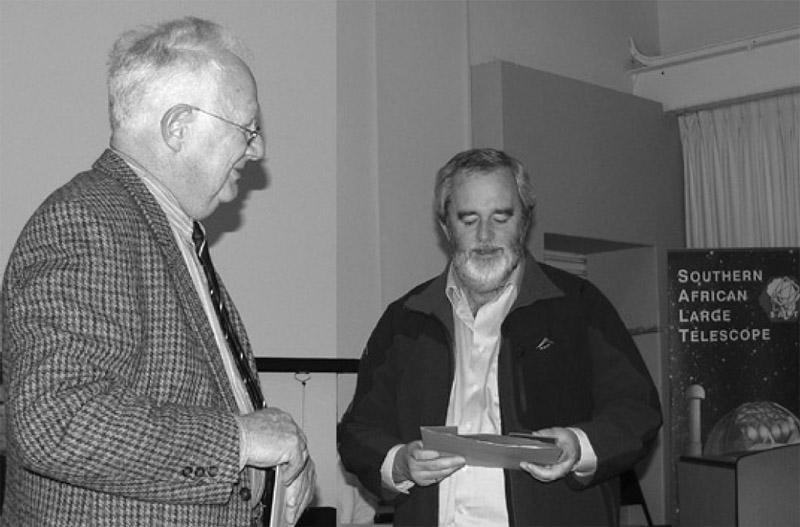The Gill Medal of our Society, its highest honour, is awarded for exceptional services to astronomy, particularly in Southern Africa.
It was announced at the Annual General Meeting of ASSA, held in Pretoria on 3 August, that Council had decided to award the Medal this year to Dr Darragh O’Donoghue of the SALT project. The actual hand-over of the Medal took place on 10 August at the Annual General Meeting of the Cape Centre, held at the SAAO.

Dr Darragh O’Donoghue (right) receiving the Gill Medal from ASSA President, Dr Ian S. Glass, during the Cape Centre AGM. Image courtesy Maciej Soltynski.
In introducing Dr O’Donoghue to the meeting, Dr Ian Glass, President of ASSA, mentioned that he had contributed to the success of SALT in two very different ways. Firstly, his unique optical design had greatly increased the capability of the telescope compared to the prototype, the Hobby-Eberly telescope in Texas, USA, by greatly increasing its fi eld of good defi nition. Secondly, Dr O’Donoghue and his team had saved the SALT project from disaster by diagnosing and correcting deficiencies in its mechanical design that had caused its actual optical performance to be unexpectedly poor. A lengthy process of checking, measurement and remedial action had eventually brought the telescope to its full potential.
The following citation was read:
“The Southern African Large Telescope (SALT) is an evolution of the Hobby- Eberly Telescope (HET) at McDonald Observatory in Texas, USA. Arguably the key component of both SALT and HET is the Spherical Aberration Corrector (SAC) which enables light from the spherical primary mirror to be brought to a sharp focus. Dr Darragh O’Donoghue re-designed and greatly improved the original HET SAC design enabling it to optimally utilize the entire collecting surface of SALT’s primary mirror and positioning the focal plane in a more advantageous position for the associated instrumentation. In particular, the SALT SAC has more than four times the field of view of the HET SAC and a signifi cantly betier theoretical image quality across the entire field.
During the commissioning of SALT it became apparent that the image quality (IQ) varied over the fi eld of view (it exhibited a focus gradient and other variable image defects). Dr O’Donoghue initiated and led the investigation into the identifi cation of the causes of the IQ problem and subsequently set-up and led a team of scientists, engineers and technicians to address and correct the problem. This investigation required identifying the source of the IQ problem (the SAC), its cause (very poor mechanical design of the SAC mounting to the telescope) and its correction (a kinematic mount following complete disassembly, testing and re-alignment of the SAC mirrors). On 29 August 2010 Dr O’Donoghue was able to announce that the IQ problem had been successfully solved. Not only did this mean that SALT would be able to operate within its design parameters, but it also showed that South Africa has the capacity, and ability, to successfully design, and maintain scientifi c equipment of the highest technological demands. In addition this entire process has led to a betier understanding of the SALT spherical mirror paradigm and how it operates.
Dr O’Donoghue’s ability, dedication and outstanding eff orts in designing and maintaining the SAC and leading his IQ team to this result should be recognised and loudly applauded by the South African scientific community and makes him a very worthy recipient of the Gill Medal.”
In thanking the Society for its award, Dr O’Donoghue drew attention to the support he had received from the other team members.
